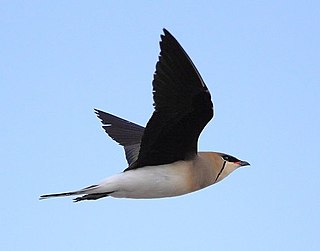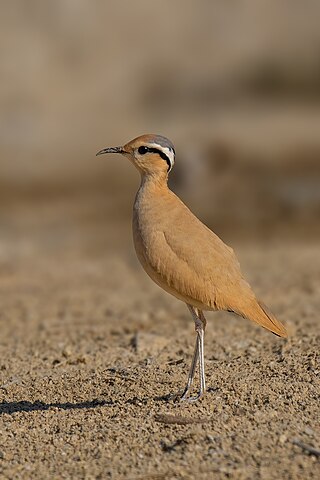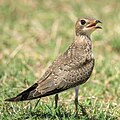
The pratincoles or greywaders are a subfamily (Glareolinae) of birds which together with the coursers make up the family Glareolidae. They have short legs, very long pointed wings and long forked tails.

Glareolidae is a family of birds in the wader suborder Lari. It contains two distinct groups, the pratincoles and the coursers. The atypical Egyptian plover, traditionally placed in this family, is now known to be only distantly related.

The wood sandpiper is a small wader belonging to the sandpiper family Scolopacidae. A Eurasian species, it is the smallest of the shanks, a genus of mid-sized, long-legged waders that largely inhabit freshwater and wetland environments, as opposed to the maritime or coastal habitats of other, similar species.

The collared pratincole, also known as the common pratincole or red-winged pratincole, is a wader in the pratincole family, Glareolidae. As with other pratincoles, it is native to the Old World.

The black-winged pratincole is a wader in the pratincole bird family, Glareolidae. The genus name is a diminutive of Latin glarea, "gravel", referring to a typical nesting habitat for pratincoles. The species name commemorates the Finnish-born zoologist and explorer Alexander von Nordmann.

The cream-colored courser is a species of wader in the pratincole and courser family, Glareolidae. Both parts of the scientific name derive from Latin cursor, "runner", from currere, "to run" which describes their usual habit as they hunt their insect prey on the ground in dry open semi-desert regions of the Middle East and northern Africa.

The small pratincole, little pratincole, or small Indian pratincole is a small wader in the pratincole family, Glareolidae.

Glareola is a genus of birds in the family Glareolidae. The pratincoles are a group of birds consisting of the seven species of this genus and the Australian pratincole, the only species of the genus Stiltia.

The white-eyed river martin is a passerine bird, one of only two members of the river martin subfamily of the swallows. Since it has significant differences from its closest relative, the African river martin, it is sometimes placed in its own genus, Eurochelidon. First found in 1968, it is known only from a single wintering site in Thailand, and may be extinct, since it has not been seen since 1980 despite targeted surveys in Thailand and neighbouring Cambodia. It may possibly still breed in China or Southeast Asia, but a Chinese painting initially thought to depict this species was later reassessed as showing pratincoles.

The rock pratincole is a species of bird in the family Glareolidae.

The Australian pratincole is a species of bird in the family Glareolidae. It breeds in Australia's interior and winters in northern and eastern parts of the continent, Indonesia and New Guinea. It is a medium-sized nomadic shorebird but is commonly found in arid inland Australia. It breeds predominantly from south-western Queensland to northern Victoria, and through central Australia to the Kimberley region in Western Australia. The Australian population is estimated at 60,000 individuals.
















